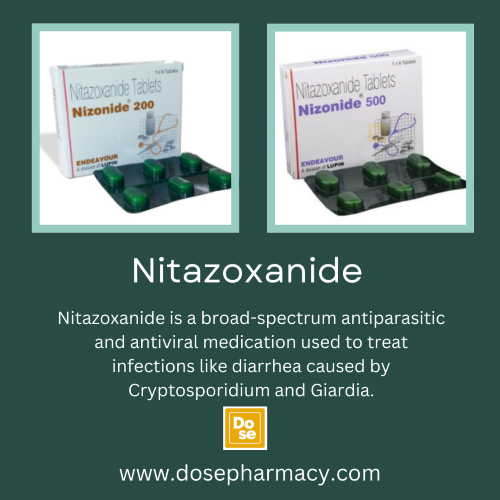Nitazoxanide 500 mg is an antiparasitic and antiviral medication that is commonly prescribed to treat a variety of parasitic infections affecting the gastrointestinal tract. Known for its broad-spectrum activity, Nitazoxanide is particularly effective against protozoa like Giardia lamblia and Cryptosporidium parvum, both of which can cause watery diarrhea and digestive discomfort. Approved for both adults and children, Nitazoxanide is considered a safe and effective option when used correctly.
In this detailed guide, we’ll explore everything you need to know about Nitazoxanide dosage for parasitic infections—including its mechanism of action, common indications, proper dosages by age and condition, treatment durations, and key precautions.
What Is Nitazoxanide?
Nitazoxanide 200 mg is a synthetic antiparasitic medication that works by interfering with the energy metabolism of parasites. Once ingested, it is rapidly converted into its active form, tizoxanide, which inhibits enzymes essential for anaerobic energy production in protozoa and some anaerobic bacteria.
It is used to treat infections such as:
- Giardiasis
- Cryptosporidiosis
- Helminth (worm) infections (in some cases)
- Amebiasis (off-label)
- Parasitic diarrhea in children and adults
Nitazoxanide is available in tablet and oral suspension (liquid) forms, making it easy to dose across age groups.
Recommended Dosage Based on Condition and Age
a. Giardiasis and Cryptosporidiosis in Adults and Adolescents (≥12 years)
- Dosage: 500 mg orally every 12 hours
- Duration: 3 days
- Form: Tablets or suspension (use 25 mL of 100 mg/5 mL suspension if tablets are not available)
b. Giardiasis and Cryptosporidiosis in Children (1–11 years)
| Age Group | Dosage | Duration |
| 1–3 years | 5 mL (100 mg) every 12 hours | 3 days |
| 4–11 years | 10 mL (200 mg) every 12 hours | 3 days |
Note: Dosing should be based on accurate body weight if possible, and oral suspension is preferred for children.
c. Helminth Infections (Off-label Use)
Nitazoxanide has shown some effectiveness in treating certain worm infections like Ascaris lumbricoides and Trichuris trichiura. While not the first-line treatment, it may be used in specific cases.
- Dosage (adults): 500 mg every 12 hours for 3–5 days
- Dosage (children): 200 mg every 12 hours for 3–5 days
Consult a healthcare provider before using Nitazoxanide for helminths, as albendazole or mebendazole are often preferred.
How to Take Nitazoxanide
- With Food: Always take Nitazoxanide with food to improve absorption and reduce stomach upset.
- Shake Suspension Well: If using the oral liquid, shake the bottle thoroughly before each dose.
- Complete Full Course: Even if symptoms improve early, finish the entire prescribed duration to ensure full parasite eradication.
Missed Dose Guidelines
If you miss a dose:
- Take it as soon as you remember.
- If it’s nearly time for your next dose, skip the missed dose.
- Do not double the dose to catch up.
Consistency is key for successful treatment.
Dosage Adjustments for Special Populations
a. Elderly Patients
- Typically no dosage adjustment is needed.
- Monitor liver and kidney function if underlying conditions exist.
b. Patients with Liver or Kidney Disease
- No specific dosage adjustment has been established.
- Caution is advised, and medical supervision is recommended.
c. Pregnant and Breastfeeding Women
- Use only if clearly needed and prescribed by a healthcare provider.
- Safety data is limited, especially during the first trimester.
Storage and Stability
- Store tablets and suspension at room temperature (20–25°C / 68–77°F).
- Do not refrigerate the suspension.
- Keep out of reach of children.
The oral suspension should be discarded after 7 days once opened.
Possible Side Effects
Nitazoxanide is generally well-tolerated. Most side effects are mild and resolve on their own.
Common side effects:
- Nausea
- Diarrhea
- Abdominal pain
- Headache
- Discolored urine (yellow-green)
Rare but serious side effects:
- Allergic reaction (rash, itching, swelling)
- Severe abdominal pain or vomiting
- Dizziness or lightheadedness
If any severe reaction occurs, discontinue use and seek medical attention.
Drug Interactions
Nitazoxanide has few known interactions but may affect or be affected by:
- Warfarin (increased bleeding risk)
- Immunosuppressants (effectiveness may vary)
- Other antiparasitic medications (consult your doctor for combination therapies)
Always inform your healthcare provider of all medications and supplements you’re taking.
What to Expect During Treatment
Most patients see improvement in symptoms like diarrhea, bloating, or abdominal discomfort within 24–48 hours. However, a full 3-day course is necessary to completely clear the infection.
In cases of resistant or recurring parasitic infections, a longer course or combination therapy may be needed. Stool tests may be recommended post-treatment to confirm eradication.
When to See a Doctor
Seek medical help if:
- Symptoms worsen after starting treatment
- You have persistent diarrhea for more than 5 days
- You experience severe dehydration
- There are signs of allergic reaction
- You’re treating a child under 12 months
Your doctor may recommend laboratory tests or a different treatment plan if Nitazoxanide is ineffective.
Comparison with Other Antiparasitic Drugs
| Parasite | Nitazoxanide | Alternative First-Line Treatment |
| Giardia lamblia | Effective | Metronidazole, Tinidazole |
| Cryptosporidium | First choice | Supportive therapy in immunocompromised |
| Ascaris | Moderately effective | Albendazole, Mebendazole |
| Trichuris | Some effect | Mebendazole |
Nitazoxanide has the advantage of a shorter course and fewer side effects compared to metronidazole, especially in children.
Nitazoxanide is a powerful and versatile medication used for treating parasitic infections, particularly in the digestive system. Whether you’re dealing with Giardia, Cryptosporidium, or a suspected worm infection, using the correct dosage is critical for effective treatment. When taken as prescribed and with proper guidance, Nitazoxanide offers quick relief with minimal side effects.
Always consult your healthcare provider for personalized dosage recommendations, especially for young children, pregnant women, or patients with chronic conditions. Completing the full course and maintaining good hygiene practices can ensure the infection is fully eradicated and prevent reinfection.
Understanding the proper dosage and use of Nitazoxanide is the first step in recovering from parasitic infections and regaining your digestive health.



